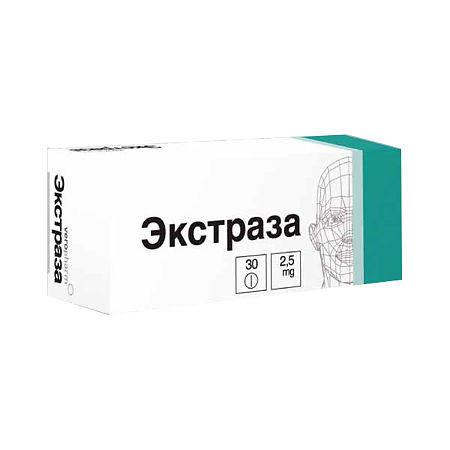No products in the cart.
Description
Letrozole is an antitumor agent.
Pharmacodynamics
Letrozole selectively inhibits aromatase (enzyme of estrogen synthesis) by a highly specific competitive binding to the subunit of this enzyme – cytochrome P450 heme. It blocks estrogen synthesis in both peripheral and tumor tissues.
In postmenopausal women, estrogens are formed mainly with the participation of aromatase enzyme, which converts androgens synthesized in adrenal glands (primarily androstenedione and testosterone) into estrone and estradiol. Daily administration of letrozole leads to a decrease in plasma concentrations of estradiol, estrone, and estrone sulfate by 75-95% of the initial content. Disruption of steroid hormone synthesis in the adrenal glands is not observed. Suppression of estrogen synthesis is maintained during treatment.
Blockade of estrogen biosynthesis does not lead to the accumulation of androgens, which are precursors of estrogen. No changes in plasma concentrations of luteinizing and follicle-stimulating hormones and no changes in thyroid function were noted in patients receiving Extrose.
Pharmacokinetics
Letrozole is rapidly and completely absorbed from the gastrointestinal tract, the average bioavailability is 99.9%. Food slightly reduces the absorption rate, but this has no clinical significance, so letrozole can be taken regardless of meals.
The binding of letrozole to plasma proteins is approximately 60% (predominantly to albumin – 55%). The equilibrium concentration is reached within 2-6 weeks of daily administration of a daily dose of 2.5 mg. Pharmacokinetics is non-linear. No cumulation was noted with long-term use.
Letrozole is largely metabolized by the CYP3A4 and CYP2A6 isoenzymes of cytochrome P450 to form a pharmacologically inactive carbinol compound.
Extracted mainly by kidneys as metabolites, to a lesser extent – through intestine. Final T1/2 is 48 hours.
Extracted from plasma by hemodialysis.
The pharmacokinetic parameters of letrozole do not depend on the age of the patient.
In renal failure the pharmacokinetic parameters do not change.
In moderately severe hepatic impairment (Child-Pugh B) the average AUC values, although higher by 37%, remain within the range of values observed in persons without hepatic impairment. In patients with cirrhosis and severe liver dysfunction (Child-Pugh C) AUC is increased by 95% and T1/2 – by 187%. However, taking into account good tolerability of high doses of the drug (5-10 mg/day), there is no need to change the dose of letrozole in these cases.
Indications
Indications
Common hormone-dependent forms of breast cancer in postmenopausal women (naturally or artificially induced).
Active ingredient
Active ingredient
Composition
Composition
1 film-coated tablet contains:
the active ingredient:
letrozole 2.5 mg,
excipients:
Lactose monohydrate;
Corn starch;
MCC;
sodium carboxymethyl starch;
colloidal silicon dioxide (aerosil);
Magnesium stearate
coating composition:
Opadry II – hypromellose (hydroxypropyl methylcellulose), titanium dioxide, lactose monohydrate, macrogol (PE 4000), iron oxide yellow, quinoline yellow dye, iron oxide black
How to take, the dosage
How to take, the dosage
The extract is taken orally, 2.5 mg once a day, daily, for the duration of the disease progression.
Interaction
Interaction
There is currently no clinical experience with the use of Letrozole in combination with other anticancer agents.
According to the results of in vitro studies, letrozole inhibits the activity of cytochrome Ð 450 isoenzymes – CYP2A6 and CYP2C19 (the latter moderately).
When deciding on the significance of these data for the clinic it must be taken into account that CYP2A6 isoenzyme does not play a significant role in drug metabolism.
In in vitro experiments it has been shown that letrozole in concentrations 100 times greater than the equilibrium values in plasma has no ability to significantly inhibit the metabolism of diazepam (substrate for CYP2C19).
Thus, clinically significant interactions with CYP2C19 isoenzyme are unlikely.
We should, however, be careful when combining letrozole with drugs that are metabolized primarily with participation of the above mentioned isoenzymes and have a narrow therapeutic index.
Special Instructions
Special Instructions
Patients with severe hepatic impairment should be kept under constant observation.
Some side effects of the drug, such as general weakness and dizziness, may affect the ability to perform potentially hazardous activities requiring concentration and quick reactions.
In this regard, caution should be exercised when driving vehicles and operating machinery.
Contraindications
Contraindications
Side effects
Side effects
Digestive system: often – nausea, vomiting, dyspepsia, constipation, diarrhea; sometimes – abdominal pain, stomatitis, dry mouth, increased liver enzyme activity.
CNS and peripheral nervous system: frequently – headache, weakness; sometimes – depression, anxiety, drowsiness, insomnia, memory impairment, dysesthesia; rarely – irritability, nervousness, hyperesthesia, hypoesthesia.
Hematopoietic system and lymphatic system: sometimes – leukopenia.
The cardiovascular system: sometimes – palpitations, tachycardia, thrombophlebitis, increased BP; rarely – pulmonary embolism, arterial thrombosis, disorders of cerebral circulation.
Respiratory system disorders: sometimes – dyspnea.
Skin and skin appendages: often – alopecia, increased sweating, skin rash; sometimes – skin itching, dry skin, urticaria.
Skeletal-muscular system: often – myalgia, arthralgia, ossalgia, arthritis.
Sensory system disorders: sometimes – cataracts, eye irritation, “blurred” vision, violation of the sense of taste.
Urinary system disorders: rarely – frequent urination.
Reproductive system disorders: sometimes – vaginal bleeding, vaginal discharge, vaginal dryness.
Others: very often – hot flashes (“hot flashes”), often – fatigue, asthenia, general malaise, peripheral edema, weight gain; sometimes – hypercholesterolemia, generalized edema, pain in tumor nodes, urinary tract infections; rarely – fever, thirst, weight loss.
Overdose
Overdose
The specific methods of treatment of overdose are unknown. Symptomatic and supportive therapy is indicated.
Similarities
Similarities
Additional information
| Weight | 0.012 kg |
|---|---|
| Shelf life | 2 years |
| Conditions of storage | In a dry, light-protected place at a temperature not exceeding 25 °C |
| Manufacturer | Veropharm AO, Russia |
| Medication form | pills |
| Brand | Veropharm AO |
Related products
Buy Extrase, tablets 2.5mg, 30 pcs. with delivery to USA, UK, Europe and over 120 other countries.












